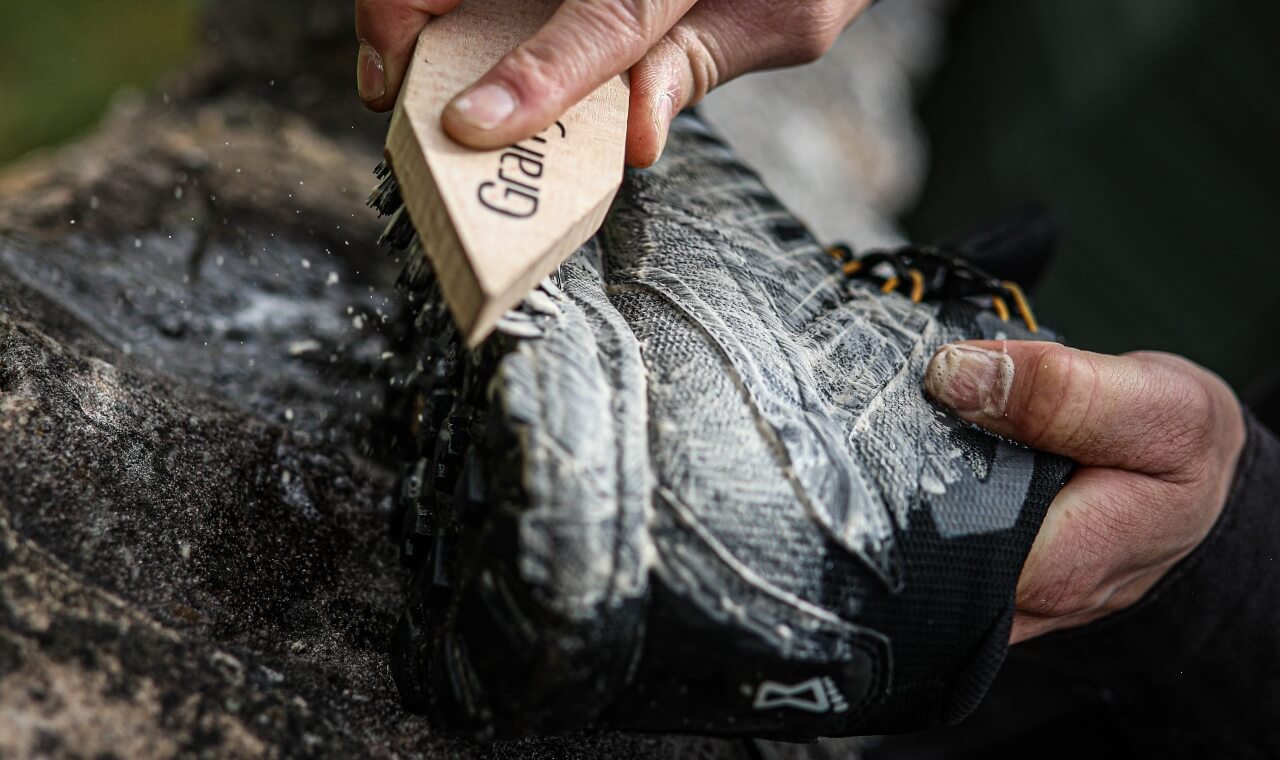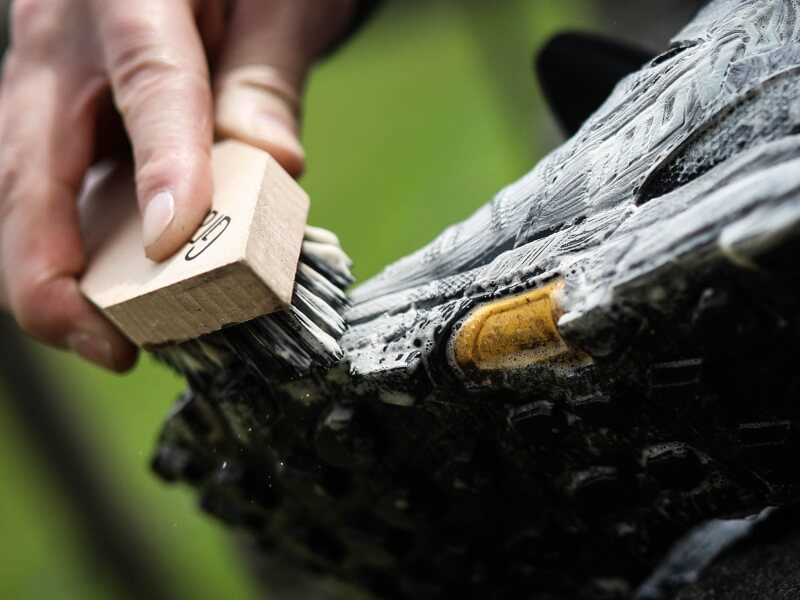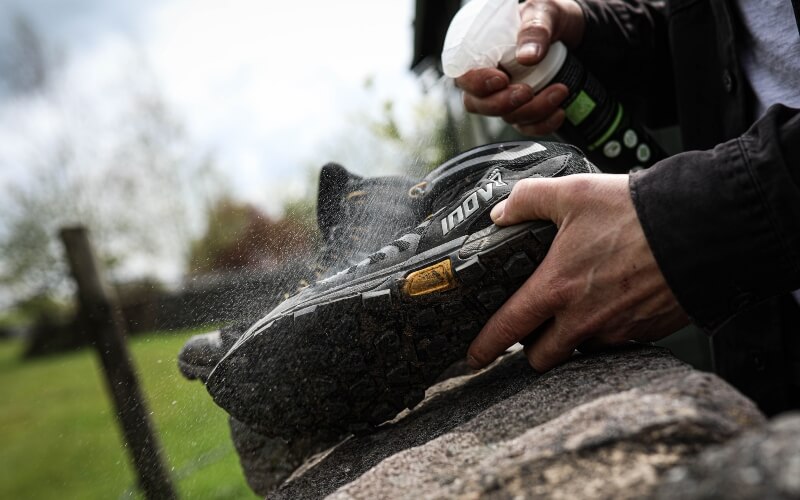
Cleaning your walking boots regularly is one of the best things you can do to increase their lifespan. We’ve compiled our best tips and tricks to help care for your boots through cleaning, drying, and re-waterproofing.

WHY CLEAN YOUR BOOTS?
One of the best ways to increase the lifespan of your boot is by regularly cleaning it.
In an age where fast-fashion is rife, looking after your shoes and clothing properly is a great way to reduce the need to buy more. It’s not only a lot nicer on your bank account, it will keep them looking and performing better for longer!
We know that you care about your hiking boots and shoes as much as we do, so we want to share some tips and tricks to make sure yours last as long as possible.
If you don't clean your hiking boots regularly, small particles of dirt will be pushed into its fabric, slowly wearing it away with every step. Dirt and grit can affect the waterproof membrane too, eventually compromising its ability to keep you dry from both the inside, from sweat, and outside, from moisture working its way through.
Thick mud stuck to the outside of your boot will stop it from drying fully, leaving it damp and eventually very smelly.

HOW TO CLEAN MUDDY WALKING BOOTS
We get it, it’s easy after a long and wet hike to throw your boots off and leave them outside saying ‘I’ll clean them in a bit…’. But the best thing for your walking boots is to get them clean and dry as soon as you can.
To clean your muddy boots:
- Ensure you tip out all the grit from inside the shoe.
- Remove laces and insoles to air dry (See further down for tips to remove any smells).
- Find a fresh water source and give your boots a quick rinse so there’s less mud to clean when you get home. If you’re not walking near water it’s worth leaving a large water bottle in your car to give them a quick rinse. Try not to soak the boots, as this can cause them to get misshapen. A quick rinse should be sufficient to get most of the mud off. Salt water can be damaging to walking boots, so avoid rinsing them in the sea.
- Find a brush with soft bristles or a regular old cloth and scrub the exterior of the boot to remove dirt and debris.
- Use a small amount of lukewarm water and a boot cleaner (we recommend using Granger’s Footwear Cleaner) to wash away any remaining dirt.
- If your boots are waterproof, now is the perfect time to re-waterproof them if they need it.

CAN YOU PUT WALKING BOOTS IN THE WASHING MACHINE?
No! Washing machines and tumble dryers are designed for cleaning and drying clothing. The heat, detergent, and roughness of the process in a washer/dryer is a combination that may well damage your shoes, or at best shorten their lifespan. It’s far better to wash your walking boots by hand.
HOW TO DRY YOUR WALKING BOOTS
Before drying your boots, remove your insoles to dry separately as soon as you can. Insoles can hold the moisture and breed bacteria when wet – it’s quicker to dry them separately.
Make sure your boots and insoles are away from any direct heat sources such as radiators, hot summer sun or fireplaces. Don’t put them in the tumble dryer.
Place your boots in a warm room, outside (but not in direct sun if it’s a hot day) or in an airing cupboard. You can speed up the drying process by:
- Removing insoles
- Removing the shoelaces from your boots
- Filling your boots with newspaper
CLEANING SMELLY WALKING BOOTS
Sometimes, even after cleaning boots, bacteria can linger. This causes that unpleasant smell we all remember from old gym bags…
Here are some techniques to help get rid of those smells:
- Remove the insole and wash thoroughly, then air dry completely. It may be that the smell is actually coming from your insoles, so you may wish to consider replacing them if the smell persists.
- Apply Grangers’ Odour Eliminator. Allow your boot to dry after cleaning and remove the insoles prior to spraying. Spray the product directly onto the fabric you wish to refresh.
- Sprinkle some baking soda (bicarbonate of soda) inside the boot, between the midsole and toe region. Baking soda absorbs and neutralises any smells instead of just covering it up.
- Double check the walking boots themselves, sometimes dirt can be a bit stubborn and might need an extra scrub to be removed.

HOW TO RE-WATERPROOF YOUR WALKING BOOTS
If you are wearing your boots regularly, you should clean and reproof your boots at least once a month. If you know that you won’t be using them for a while, we suggest cleaning and reproofing them before you put them away to avoid any dirt build up. Dirt will damage or clog up the membrane (friction leads to damage, build up affects breathability).
It’s important to get into this routine as build-up of dirt, grease and body oils on your waterproof boots can contaminate the membrane inside the fabric and affect the breathability of it. In extreme cases this contamination could cause the fabric to leak.
The best time to re-waterproof your boots is immediately after washing them. While the boot is still wet, we recommend you use Grangers Fabsil Waterproofer. This provides highly Durable Water Repellency (DWR) which develops during air drying. It leaves a flexible water repellent treatment that allows moisture vapour to pass through, maintaining breathability while keeping your feet dry.
How to use Grangers Fabsil Waterproofer to reproof your walking boots:
- Use after removing dirt from boot and using cleaning gel
- Shake well before use
- Spray generously to wet footwear. Spray from a short distance (around 5cm)
- Wait two minutes
- Then, using a cloth, remove excess liquid and allow to dry fully – then get out there!

